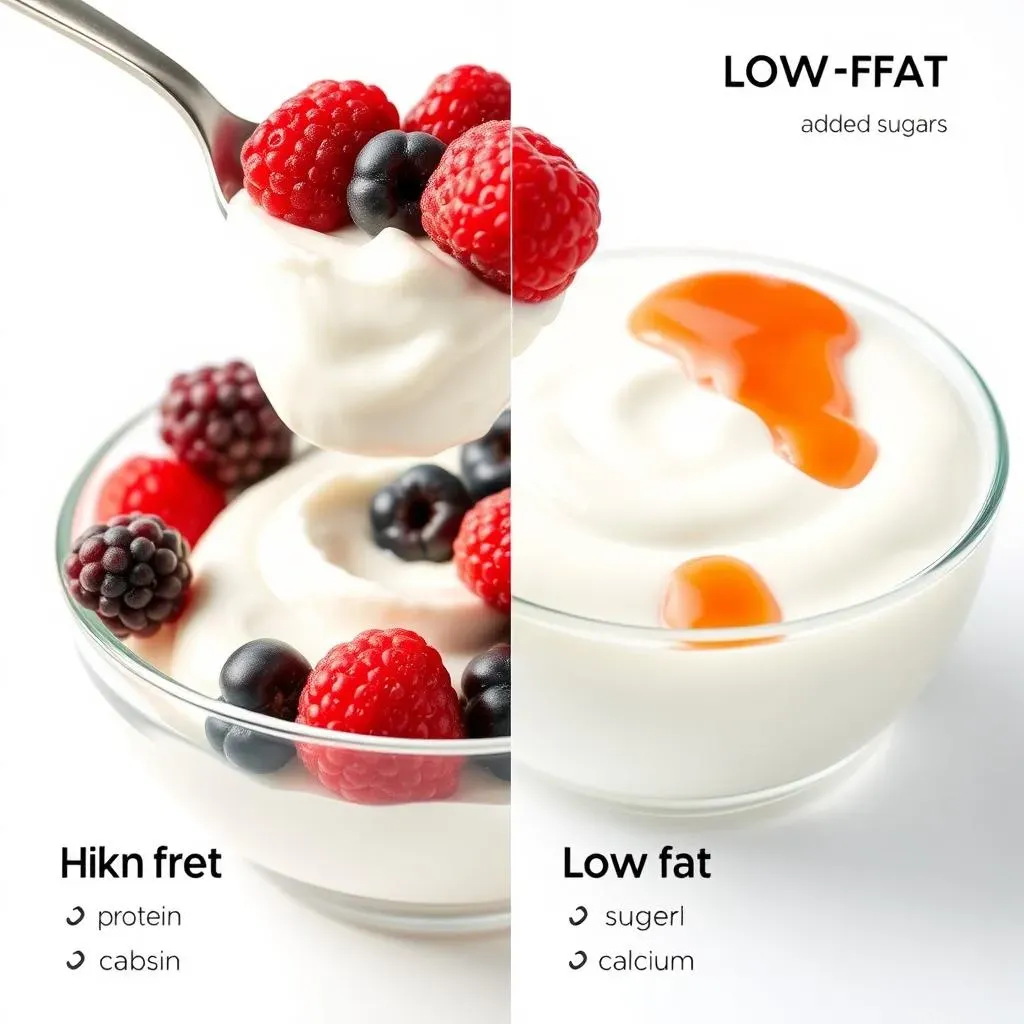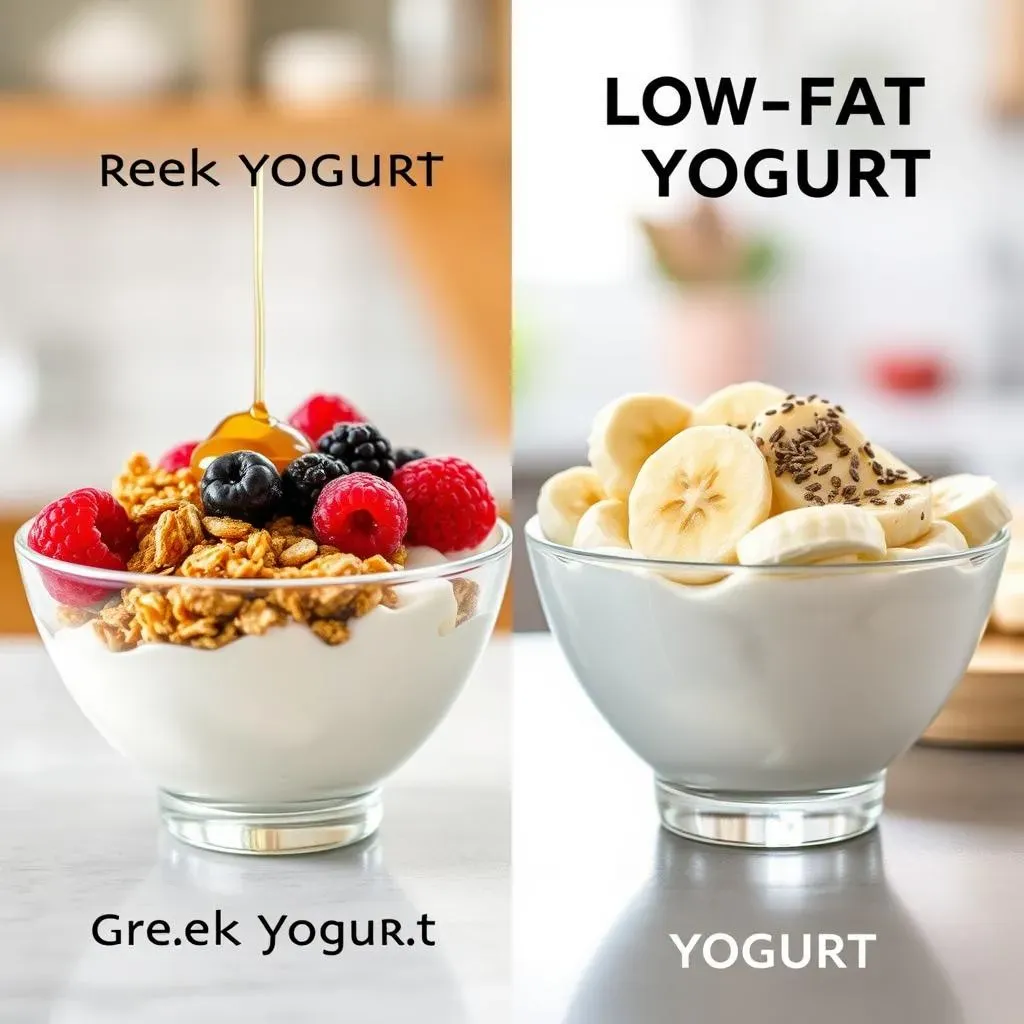Table of Contents
Walk down any grocery store aisle these days, and you're bombarded with yogurt options. From fruity flavors to protein-packed powerhouses, it's a dairy jungle out there! Two contenders often face off in the yogurt arena: Greek yogurt and low-fat yogurt. But what exactly is the difference between Greek yogurt and low fat yogurt? Is one truly healthier than the other, or does it all come down to personal preference?
What is Greek Yogurt and LowFat Yogurt?

What is Greek Yogurt and LowFat Yogurt?
What is Greek Yogurt?
Alright, let's start with Greek yogurt. Imagine taking regular yogurt and giving it a serious spa treatment. That's basically what happens. Greek yogurt is strained – like, really strained – to remove the whey, which is the liquid part. This process is why Greek yogurt ends up being so thick and creamy. Some people describe it as almost like sour cream, but with that signature yogurt tang. It's become super popular in the US over the past 15 years because everyone's realized it's not just tasty, but also packed with good stuff.
Think of it this way: you start with regular yogurt, then you put it in a cheesecloth and let all the extra liquid drip out. What's left behind is a concentrated, protein-rich, and satisfyingly thick yogurt. That straining process is the key to its unique texture and nutritional profile.
What is Low-Fat Yogurt?
Now, let's talk about low-fat yogurt. Unlike Greek yogurt, the focus here isn't on straining. Instead, it's all about reducing the fat content. During the production process, the milk used to make the yogurt has some or all of its fat removed. This results in a yogurt that's lower in calories and, of course, fat. However, it also changes the texture and sometimes the taste.
Often, to compensate for the lack of fat, manufacturers will add thickeners, sugars, or artificial sweeteners to low-fat yogurt to improve its consistency and flavor. This is something to be mindful of when you're choosing a yogurt – always check the ingredient list!
To me, low-fat yogurt can be a bit of a mixed bag. On one hand, it can be a good option if you're specifically watching your fat intake. On the other hand, the added ingredients can sometimes outweigh the benefits of the lower fat content.
Here's a quick comparison:
Feature | Greek Yogurt | Low-Fat Yogurt |
|---|---|---|
Fat Content | Varies (can be full-fat, low-fat, or non-fat) | Reduced fat |
Straining Process | Strained to remove whey | Not strained |
Texture | Thick and creamy | Thinner, may have added thickeners |
Key Differences in a Nutshell
So, what are the key differences? Greek yogurt is strained, leading to a thicker texture and higher protein content. Low-fat yogurt has had the fat removed, resulting in fewer calories from fat, but often with added ingredients to improve taste and texture. Both can be part of a healthy diet, but it's important to understand these distinctions to make the best choice for your individual needs and preferences.
Ultimately, the "best" yogurt depends on what you're looking for. Do you prioritize protein and a creamy texture? Greek yogurt might be your winner. Are you focused on minimizing fat intake? Low-fat yogurt could be a better fit, just be sure to read the label carefully!
Nutritional Differences: Greek Yogurt vs. LowFat Yogurt

Nutritional Differences: Greek Yogurt vs. LowFat Yogurt
Protein Powerhouses
let's dive into the nitty-gritty of nutrition. When it comes to protein, Greek yogurt is the clear winner. Because of that straining process we talked about, Greek yogurt packs a serious protein punch. We're talking almost double the protein of regular low-fat yogurt in some cases! This is awesome if you're trying to build muscle, feel full longer, or just want to up your protein intake. Protein is key for satiety, meaning it helps you feel satisfied after eating, which can prevent overeating later on.
Low-fat yogurt still has protein, of course, but it's significantly less. So, if you're choosing a yogurt based on protein content alone, Greek yogurt is the way to go.
Carbs and Sugar Content
Now, let's talk about carbs and sugar. This is where things get interesting. Because Greek yogurt is strained, it loses some of the lactose (milk sugar) during the process. That means it generally has fewer carbs and less sugar than low-fat yogurt. For those watching their carb intake or trying to limit added sugars, this can be a major plus. However, be aware that some brands add sugar to Greek yogurt to improve the taste, so always check the label!
Low-fat yogurt, on the other hand, often has more carbs and sugar. This is partly because the lactose isn't strained out, and partly because manufacturers sometimes add sugar to compensate for the flavor lost when the fat is removed. Again, reading the ingredient list is crucial here. You might be surprised at how much sugar some low-fat yogurts contain.
Here's a simple comparison table:
Nutrient | Greek Yogurt (per serving) | Low-Fat Yogurt (per serving) |
|---|---|---|
Protein | 15-20g | 8-10g |
Carbs | 5-10g | 15-20g |
Sugar | 5-10g (check for added sugars) | 15-20g (often with added sugars) |
Fat and Calcium Considerations
Finally, let's consider fat and calcium. Greek yogurt can come in full-fat, low-fat, or non-fat varieties, so you have options depending on your dietary needs. Full-fat Greek yogurt will obviously have more calories from fat, but it also contains healthy fats that are important for hormone production and overall health. Low-fat and non-fat Greek yogurt are good choices if you're watching your fat intake.
Low-fat yogurt, as the name suggests, is lower in fat than full-fat Greek yogurt. However, it often contains less calcium than Greek yogurt. Calcium is crucial for bone health, so this is something to keep in mind. To increase your calcium intake, you can add calcium-rich toppings to your yogurt, such as nuts, seeds, or fruit.
In summary, the nutritional differences between Greek yogurt and low-fat yogurt are significant. Greek yogurt generally wins on protein and lower sugar, while low-fat yogurt may be lower in calories (depending on added sugars and thickeners) and sometimes higher in calcium. The best choice for you depends on your individual needs and dietary goals.
Health Benefits of Greek Yogurt and LowFat Yogurt

Health Benefits of Greek Yogurt and LowFat Yogurt
Gut Health and Probiotics
Let's get real about gut health! Both Greek yogurt and low-fat yogurt are often packed with probiotics, which are those friendly bacteria that keep your digestive system humming. Think of them as tiny superheroes fighting off the bad guys in your gut. Probiotics can help with everything from improving digestion and reducing bloating to boosting your immune system. Not all yogurts contain live and active cultures, so make sure to look for that phrase on the label. It's your guarantee that the good bacteria are present and ready to work their magic!
However, the specific strains of probiotics can vary between brands and types of yogurt. Some yogurts might have a wider variety of strains, which can be beneficial for overall gut health. Others might focus on specific strains that target particular digestive issues. It's like having a team of specialists versus a general practitioner – both are valuable, but in different ways.
Weight Management Potential
Want to manage your weight? Yogurt might be your secret weapon. Greek yogurt, in particular, can be a great ally in weight management due to its high protein content. Protein helps you feel fuller for longer, which can curb cravings and prevent overeating. A study published in the "Journal of the American College of Nutrition" found that people who ate high-protein yogurt as part of a weight loss program lost more weight and body fat than those who didn't. That's some serious yogurt power!
Low-fat yogurt can also play a role in weight management, but it's important to be mindful of added sugars. Choose plain varieties and add your own healthy toppings, like berries or nuts, to control the sweetness and boost the nutritional value. Remember, it's all about making smart choices and reading those labels carefully!
Consider this:
Bone Health and Calcium
Don't forget about your bones! Both Greek yogurt and low-fat yogurt are excellent sources of calcium, which is essential for strong and healthy bones. Calcium helps to build and maintain bone density, reducing the risk of osteoporosis and fractures later in life. It's like investing in your future self, one spoonful of yogurt at a time.
While both types of yogurt provide calcium, the amount can vary depending on the brand and processing methods. Some low-fat yogurts are fortified with extra calcium, so they might actually have more than some Greek yogurts. Again, reading the label is key to making an informed choice. Pair your yogurt with other calcium-rich foods, like leafy greens or almonds, for an extra bone-boosting effect.
Benefit | Greek Yogurt | Low-Fat Yogurt |
|---|---|---|
Gut Health | Good source of probiotics | Good source of probiotics |
Weight Management | High protein promotes satiety | Lower in fat, but watch for added sugars |
Bone Health | Good source of calcium | Good source of calcium, sometimes fortified |
Taste, Texture, and Culinary Uses: Comparing Greek and LowFat Yogurt

Taste, Texture, and Culinary Uses: Comparing Greek and LowFat Yogurt
The Tangy Truth: Taste and Texture
Alright, let's get down to the delicious details! When it comes to taste, Greek yogurt has a distinct tang that some people adore and others... not so much. That tartness comes from the straining process, which concentrates the yogurt's natural acids. The texture is thick, creamy, and almost velvety, making it incredibly satisfying to eat. Think of it as the sophisticated cousin of regular yogurt, with a more complex and intriguing flavor profile.
Low-fat yogurt, on the other hand, tends to have a milder flavor. The texture is usually thinner and less rich, sometimes even a bit watery. To compensate for the lack of fat, manufacturers often add sugar or artificial sweeteners, which can make it taste sweeter than Greek yogurt. It's like the easy-going, crowd-pleasing option that's less intense but still enjoyable.
From Breakfast Bowls to Baking: Culinary Versatility
Now, let's talk about how you can use these yogurts in the kitchen. Greek yogurt is a culinary powerhouse, thanks to its thick texture and tangy flavor. It's fantastic in breakfast bowls with granola and fruit, as a base for creamy dips and sauces, or even as a substitute for sour cream in recipes. Its thickness also makes it ideal for baking, adding moisture and richness to cakes, muffins, and other baked goods. I even use it to marinate chicken sometimes – the acidity tenderizes the meat and adds a delicious flavor!
Low-fat yogurt is also versatile, but its thinner texture can limit its uses. It's great in smoothies, as a topping for pancakes or waffles, or as a light dressing for salads. However, it might not work as well in recipes that require a thicker yogurt, like dips or baking. You can try thickening it with chia seeds or gelatin, but it won't have the same richness as Greek yogurt.
Here's a quick rundown of culinary uses:
Use | Greek Yogurt | Low-Fat Yogurt |
|---|---|---|
Breakfast Bowls | Excellent | Good |
Dips and Sauces | Excellent | Okay (may need thickening) |
Baking | Excellent | Not ideal |
Smoothies | Good | Excellent |
Personal Preferences and Pairings
Ultimately, the best yogurt for you depends on your personal preferences and how you plan to use it. If you love a tangy flavor and creamy texture and want a versatile ingredient for cooking and baking, Greek yogurt is a great choice. If you prefer a milder flavor and lighter texture and are primarily using it in smoothies or as a topping, low-fat yogurt can be a good option. Don't be afraid to experiment and find what works best for you!
Consider pairing your yogurt with different toppings to enhance the flavor and nutritional value. Berries, nuts, seeds, honey, and granola are all great additions that can transform a simple bowl of yogurt into a satisfying and delicious meal or snack. Get creative and have fun with it!
Making the Right Choice: Which Yogurt is Best for You?

Making the Right Choice: Which Yogurt is Best for You?
Aligning Yogurt with Your Health Goals
so we've explored the tangy world of Greek yogurt and the lighter side of low-fat yogurt. But how do you actually decide which one is right for you? It really boils down to your individual health goals. Are you trying to pack on muscle? Greek yogurt's protein punch is your best friend. Watching your waistline? Both can work, but you'll need to be a sugar detective with those low-fat options. Thinking about your gut health? Look for that "live and active cultures" label on either one!
Think of it like choosing a workout routine. There's no one-size-fits-all. What works for your gym buddy might not be the best for you. Consider your personal needs, preferences, and any dietary restrictions you might have. And remember, it's not an all-or-nothing game. You can enjoy both Greek and low-fat yogurt as part of a balanced diet.
Decoding Labels and Ingredients
Speaking of sugar detectives, let's talk labels. This is where things can get sneaky. Don't just grab the yogurt with the prettiest packaging. Flip it over and take a close look at the nutrition facts and ingredient list. Pay attention to serving size, calories, protein, fat, carbs, sugar, and sodium. And don't be fooled by health claims on the front – they're often just marketing tactics. The real truth is on the back!
Look out for added sugars, like high-fructose corn syrup, sucrose, or artificial sweeteners. The fewer ingredients, the better. Ideally, your yogurt should contain just milk and live cultures. If you're concerned about fat, choose a low-fat or non-fat variety. But remember, healthy fats are important too, so don't be afraid of full-fat yogurt in moderation.
Here's a checklist to guide you through the label jungle:
- Serving Size: Is it realistic for how much you actually eat?
- Calories: Does it fit into your daily calorie goals?
- Protein: How much protein are you getting per serving?
- Fat: What type of fat is it (saturated, unsaturated, trans)?
- Carbs: How many carbs are from sugar versus fiber?
- Sugar: Is there added sugar? If so, how much?
- Ingredients: Are there any artificial sweeteners, flavors, or colors?
Beyond the Bowl: Creative Ways to Enjoy Yogurt
Let's face it, eating the same thing every day can get boring. So, how can you keep your yogurt routine exciting? Get creative! Yogurt is incredibly versatile and can be used in countless ways. Think beyond the breakfast bowl. Use Greek yogurt as a marinade for chicken or fish, blend it into smoothies, or make a creamy dip for veggies. Low-fat yogurt is great in overnight oats, as a topping for tacos, or even as a substitute for mayonnaise in sandwiches. The possibilities are endless!
Experiment with different toppings and flavors. Add fresh fruit, nuts, seeds, granola, honey, cinnamon, or even a sprinkle of dark chocolate. You can also make your own flavored yogurt by blending in your favorite fruits or extracts. The key is to have fun and find ways to incorporate yogurt into your diet that you actually enjoy. After all, healthy eating shouldn't feel like a chore!
Consider this:
Making the Final Call: Greek Yogurt vs. Low-Fat Yogurt
So, which yogurt reigns supreme? It really depends on your individual needs and preferences. If you're prioritizing protein, healthy fats, and satiety, Greek yogurt is likely your best bet. However, if you're watching your calorie intake or need a more budget-friendly option, low-fat yogurt can still be a nutritious choice. Ultimately, the "healthiest" yogurt is the one you enjoy eating and that fits into your overall balanced diet. Don't be afraid to experiment with both to discover your personal favorite!
